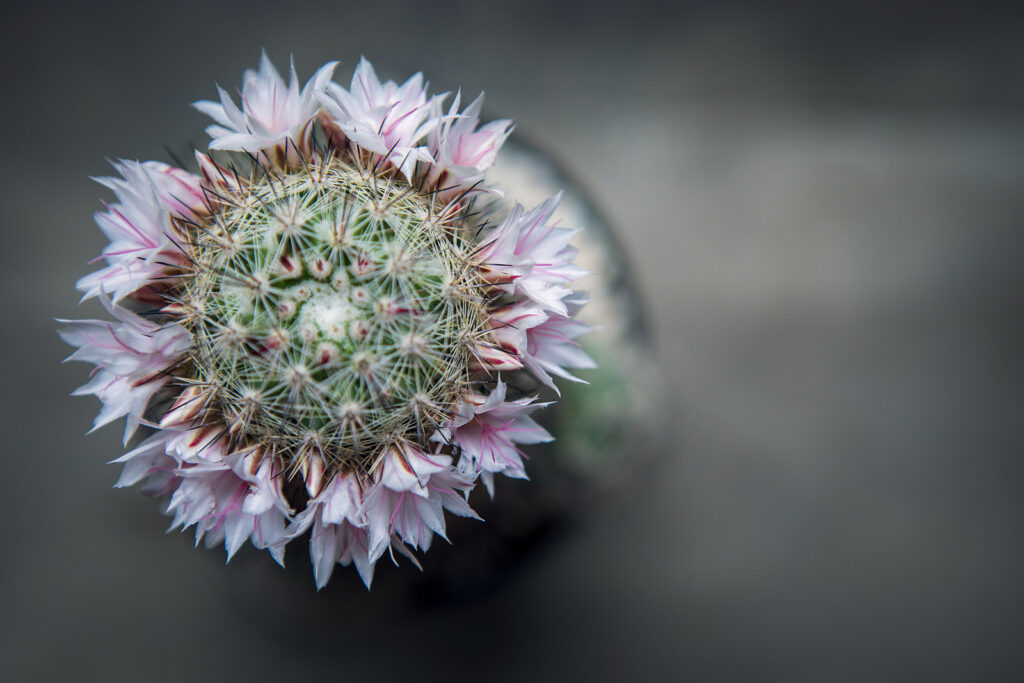Coryphantha is a pincushion cactus that resembles Mammillarias, perhaps the best-known pincushion cacti. Unlike Mammillaria, however, Coryphantha is globular or cylindrical in form. Coryphantha grows to 12 inches (30 cm) tall and 4 inches (10 cm) thick. Coryphantha cluster in mounds and often become columnar with age.
Coryphantha are free-flowering. They produce large, showy flowers 1 to 3 inches long in spring or summer. Flowers are red, yellow, or purple, though rare species bear white ones. Coryphantha flowers resembles Mammillaria, but differs by producing blooms on the new growth instead of the old. Flowers appear in summer or fall.
Coryphantha are easy to grow and readily available. There are 66 species in the genus. Coryphantha are native to Mexico and parts of the Southwest.
Get to know Coryphantha
- Plant type: Cactus, pincushion cactus
- Hardiness temperature: 35℉ (1.7℃)
- Optimal growing temperature: day, 80° to 90°F (27° to 32°C); night, 60° to 70°F (16° to 21°C).
- Shape and size: Cluster in large mounds or become columnar with age growing as tall as 12 inches (30cm); flowers and spiny areas are joined by a wolly groove.
- Flowers: Large, showy flowers (1-3 inches long); red, yellow, or purple blooms
- Bloom time: Spring and summer
- Common name: Coryphantha
- Genus name: Coryphantha
- Family name: Cactaceae
- Origin: Mexico

Planting Coryphantha
- Grow Coryphantha in full sun to partial shade.
- Grow Coryphantha indoors in bright, filtered light from southern, southeastern, or eastern exposure. Fresh air circulation is important.
- Grow Coryphantha in soil that contains lots of nutritent sals and calcium sulfate, but no humus.
How to water and feed Coryphantha
- Water Coryphantha infrequently in summer. Let the soil dry between thorough waterings.
- Feed Coryphantha every 6 weeks while in bloom, with low-nitrogen, high-potassium fertilizer.
- Keep Corphantha dry, light, and cool in winter.
Coryphantha care
- Coryphantha rarely needs repotting, as growth is very slow.
- Check for aphids, mealybugs, spider mites, scale. Also be alert for fungus disease and rot.
- Let Coryphantha rest from fall to early spring. Place the plant in a cool, bright location where it receives 5 hours of sun daily. Give just enough water to keep the plant from shriveling and withhold fertilizer.
- Propagate Coryphantha from seed or offsets.
Coryphantha species to grow
- Coryphantha bumamma. Globelike form, bearing brown spines and large spines and large yellow flowers.
- C. clava. Cylindrical form; cone-shaped tubercles carry red, brown, or yellow spines; pale yellow flowers are tinged with red.
- C. corniflera. Globular plant to 5 inches tall; spirally configurated tubercles; yellow spines turn gray with age; yellow flowers are 2 inches long, appear in summer.
- C. elephantidens. Globular in shape, with a blue-green cast; features brown spines and white wool; produces large, rosy pink flowers.
- C. macromeris (donna anna cactus). Clustering 5-inch stems and loose tubercles; radial spines are white, needle-shaped; central spines are shorter, darker; purple flowers to 3-inches long in summer.
- C. missourlensis. Small species, usually under 3 inches high; stout spines, one of which is long and directed outward; greenish yellow, fragrant flowers.
- C. sheeri. Radial spines are yellow tipped with red; showy flowers to 3 inches wide are either yellow or streaked with red or pink.
- C. strobilliformis. Compact, grows to 5-inch-tall species has bright pink or purple flowers. C. s. durisina and C. s orcutti are recognized varieties.
- C. vivipara. Globular plant has unique spination; the central spine is directed outward, the others down. Varieties include C. v alversonil grows to 6 inches high and branches: C. v bisbeeana (gold ball cactus) mounds or slightly branched; both have pink flowers about 1 ½ inches wide.















